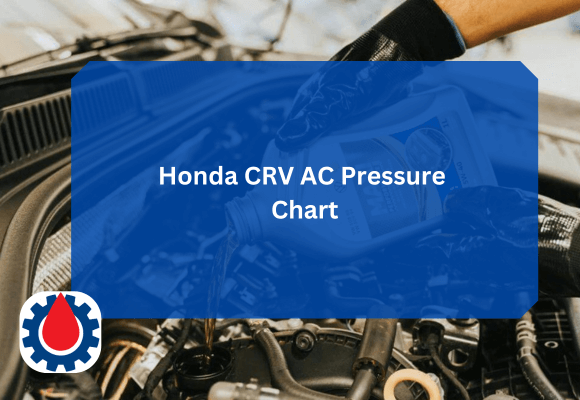One key aspect of maintaining peak AC performance is monitoring the AC system pressure. Whether you’re recharging refrigerant, troubleshooting cooling problems, or performing regular maintenance, knowing the correct AC pressure for your model year is crucial.
This guide provides a comprehensive Honda CR-V AC pressure chart for different model years, refrigerant types (R-134a and R-1234yf), and ambient temperature conditions.
Honda CRV AC Pressure Chart
| Model Year | Refrigerant Type | Ambient Temp (°F) | Low Side (psi) | High Side (psi) |
|---|---|---|---|---|
| 1997 – 2001 | R-134a | 75°F | 25 – 35 | 180 – 220 |
| 2002 – 2006 | R-134a | 80°F | 30 – 40 | 200 – 250 |
| 2007 – 2011 | R-134a | 85°F | 32 – 42 | 210 – 260 |
| 2012 – 2014 | R-134a | 90°F | 35 – 45 | 220 – 270 |
| 2015 – 2016 | R-134a | 95°F | 36 – 46 | 230 – 280 |
| 2017 – 2019 | R-1234yf | 75°F | 20 – 30 | 150 – 200 |
| 2020 – 2022 | R-1234yf | 85°F | 25 – 35 | 180 – 230 |
| 2023 – 2025 | R-1234yf | 90°F | 28 – 38 | 190 – 240 |
Related Car AC PSI Chart(Complete Guide)
Understanding the Readings
Low-Side Pressure (Suction Pressure):
- Indicates refrigerant returning to the compressor. If it’s too low, the system may have a refrigerant leak or a restricted expansion valve. If too high, the compressor might be weak or there’s an overcharge.
High-Side Pressure (Discharge Pressure):
- Represents the pressure leaving the compressor and heading toward the condenser. High readings may indicate overcharging, poor airflow, or a clogged condenser. Low readings could mean low refrigerant or compressor issues.
Related Car AC Gauge Reading Chart(Complete Guide)
Refrigerant Type Transition
Older CR-V models (1997–2016) used R-134a, while newer models (2017 onward) transitioned to R-1234yf, a more environmentally friendly refrigerant with lower global warming potential (GWP). Both refrigerants require specific pressures and different service fittings to prevent cross-contamination.
Key Difference:
- R-1234yf operates at slightly lower pressures.
- Using the wrong refrigerant can damage the AC system and void warranties.
How to Check AC Pressure
1. Locate the Service Ports:
The low-pressure port is usually on the larger aluminum line, while the high-pressure port is on the smaller line near the condenser.
2. Attach AC Gauges:
Use a manifold gauge set designed for your refrigerant type. Blue hose connects to the low side, red to the high side.
3. Start the Engine and AC:
Set AC to maximum cooling, with blower speed high and windows open. Allow a few minutes for stable readings.
4. Record Pressures:
Compare your readings to the table above. Always match the values to the current ambient temperature.
Related 134a A/C Pressure Chart(Complete Guide)
AC Pressure Problems and Causes
| Condition | Low Side Reading | High Side Reading | Likely Cause |
|---|---|---|---|
| Low | Low | Low | Low refrigerant charge |
| High | High | High | Overcharge, blocked condenser, poor airflow |
| Low | High | High | Restriction in expansion valve or orifice tube |
| High | Low | Low | Faulty compressor |
| Normal | High | Low | Weak compressor or internal leak |
Related AC Vent Temperature Chart(Complete Guide)
Best Practices for Maintaining Your CR-V AC System
- Check refrigerant level yearly: Slight losses occur naturally. Top-up if below range.
- Clean condenser fins: Dirt buildup restricts airflow and raises system pressure.
- Replace cabin air filter regularly: A clogged filter affects AC performance.
- Run AC periodically: Keeps seals lubricated and prevents leaks.
- Inspect compressor clutch operation: A Clicking sound indicates clutch engagement.
- Use the correct oil type: Honda CR-V systems often require PAG 46 or SP-A2 oil (check service manual).
Signs Your Honda CR-V AC System Needs Service
- The AC blows warm or inconsistent air.
- Compressor fails to engage.
- Unusual hissing or clicking noises.
- Moisture or oil residue near fittings.
- Visible frost on AC lines.
Related AC System Pressure Chart(For All Refrigerant Types)
FAQs
What is the correct refrigerant for my Honda CR-V?
- Models 1997–2016 use R-134a.
- Models 2017 and newer use R-1234yf.
What should the AC pressure be on a Honda CR-V?
Depending on the year and refrigerant type, normal pressures typically range between 25–45 psi (low side) and 180–270 psi (high side).
Can I use R-134a in an R-1234yf system?
No. They are not interchangeable. R-1234yf systems require specific fittings, oil, and charge amounts. Using R-134a can damage the system.
Why is my CR-V’s AC not blowing cold air?
Possible reasons include low refrigerant, a clogged expansion valve, a bad compressor, or restricted condenser airflow.
How much refrigerant does a Honda CR-V need?
Most models require between 17 to 21 ounces (500–600 grams) of refrigerant, depending on the year and system type.




